
Nissan Micra: Flat tire
Nissan Micra Owners Manual
CHANGING A FLAT TIRE
If you have a flat tire, follow the instructions below:
Stopping the vehicle
- Safely move the vehicle off the road and away from traffic.
- Turn on the hazard warning flashers.
- Park on a level surface and apply the parking brake. Shift the automatic transmission (A/T) or the models into P (Park) or the manual transmission (M/T) model into R (Reverse).
- Turn off the engine.
- Raise the hood to warn other traffic and to signal professional road assistance personnel that you need assistance.
- Have all passengers get out of the vehicle and stand in a safe place, away from traffic and clear of the vehicle.
WARNING
|
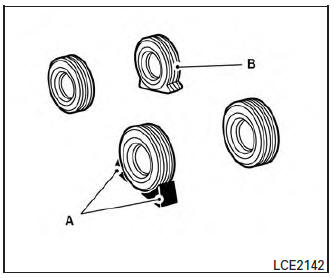
- Blocks
- Flat tire
Blocking wheels
Place suitable blocks at both the front and back of the wheel diagonally opposite the flat tire to prevent the vehicle from moving when it is jacked up.
| WARNING Be sure to block the wheel as the vehicle may move and result in personal injury. |
Getting the spare tire and tools
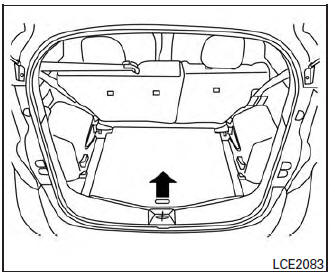
Open the rear hatch.
Lift the floorboard.
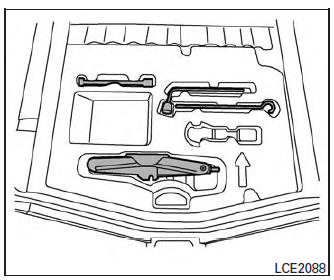
- Remove the jacking tools from the storage location.
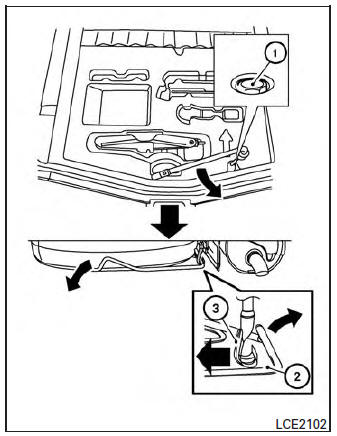
- Loosen the bolt 1 counterclockwise to lower the spare.
- Stop turning the bolt when the spare is lowered to the point where the tire basket 2 can be removed from the hook 3 .
- Remove the wheel basket by pushing the basket upward.
- Lower the tire basket to the ground and take out the spare.
Removing wheel cover (if so equipped)
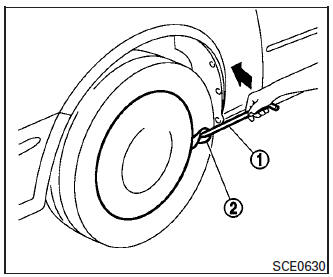
To remove the wheel cover, use the jack rod 1 as illustrated.
Apply cloth 2 between the wheel and jack rod to prevent damaging the wheel and wheel cover.
| CAUTION Do not use your hands to pry off wheel caps or wheel covers. Doing so could result in personal injury. |
Use caution not to scratch the wheel cover or wheel surface.
Jacking up vehicle and removing the damaged tire
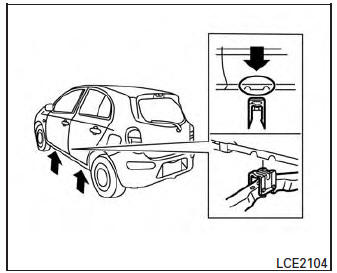
WARNING
|
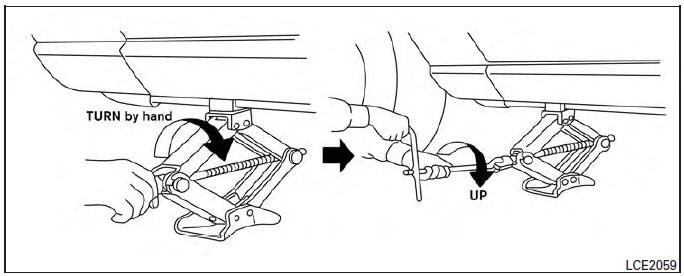
Always refer to the proper illustrations for the correct placement and jack-up points for your specific vehicle model and jack type.
Carefully read the caution label attached to the jack body and the following instructions.
- Loosen each wheel nut 1 or 2 turns by turning counterclockwise with the wheel nut wrench. Do not remove the wheel nuts until the tire is off the ground.
- Place the jack directly under the jack-up
point as illustrated so the top of the jack
contacts the vehicle at the jack-up point.
Align the jack head between the 2 notches in the front or the rear as shown. Also fit the groove of the jack head between the notches as shown.
The jack should be used on firm and level ground.
- To lift the vehicle, securely hold the jack lever and rod with both hands. Carefully raise the vehicle until the tire clears the ground. Remove the wheel nuts, and then remove the tire.
Installing the spare tire
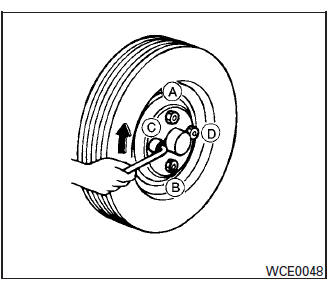
- Clean any mud or dirt from the surface between the wheel and hub.
- Carefully put the spare tire on and tighten the wheel nuts finger tight.
- With the wheel nut wrench, tighten wheel nuts alternately and evenly in the sequence illustrated ( A , B , C , D ) until they are tight.
- Lower the vehicle slowly until the tire
touches the ground. Then, with the wheel
nut wrench, tighten the wheel nuts securely in the sequence illustrated ( A
, B , C , D ).
Lower the vehicle completely.
WARNING
|
As soon as possible, tighten the wheel nuts to the specified torque with a torque wrench.
Wheel nut tightening torque: 113 N·m (83 ft-lb)
The wheel nuts must be kept tightened to specification at all times. It is recommended that wheel nuts be tightened to specification at each lubrication interval.
Adjust tire pressure to the COLD pressure.
COLD pressure: After the vehicle has been parked for 3 hours or more or driven less than 1.6 km (1 mile).
COLD tire pressures are shown on the “Tire and loading information label”.
- Securely store the flat tire and jacking equipment in the vehicle.
| WARNING
Always make sure that the spare tire and
jacking equipment are properly secured
after use. Such items can become dangerous
projectiles in an accident or sudden
stop.
The spare tire is designed for emergency use. For additional information, refer to “Wheels and tires” in the “Maintenance and do-it-yourself” section of this manual. |
Reinstalling the temporary spare tire to its original position
After the flat tire is repaired, return the temporary spare to its original position in the tire basket under the rear of the vehicle.
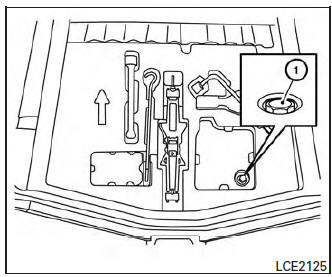
- Open the rear hatch.
- Remove the luggage floor.
- Loosen bolt 1 counterclockwise approximately 20 turns using the wheel nut wrench and wrench extension to lower the tire basket.
- Stop turning the bolt when the tire basket is lowered to a place where it can be removed from the hook. Do not loosen the bolt excessively, otherwise the basket may fall suddenly.
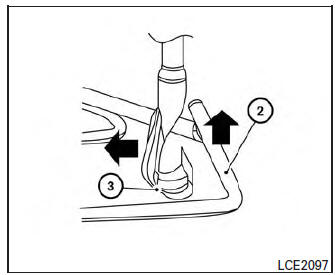
- Hold the tire basket and remove it from the hook by pushing the basket 2 upward and moving the hook 3 to release the basket.
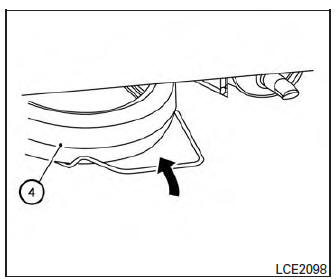
- Lower the tire basket slowly to the ground and then put in the temporary spare tire 4
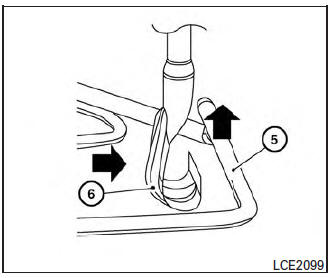
- Reinstall the tire basket by pushing upward on the basket 5 and inserting the hook 6
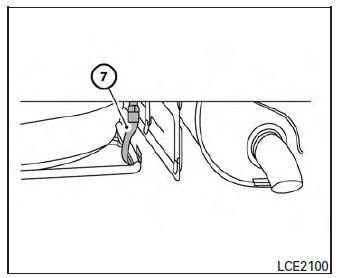
Please be sure that the hook is located as shown in the image 7 . The hook must engage from the inside of the basket.
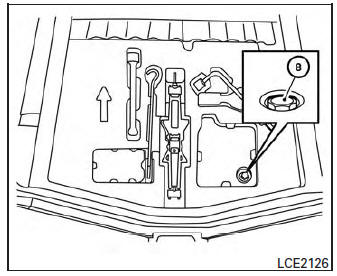
- Tighten the bolt 8 clockwise until the bolt is tight using the wheel nut wrench and wrench extension to move the tire basket up to the holding position.
WARNING
|
Stowing the damaged tire
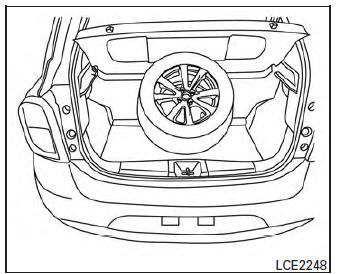
Securely store the damaged tire in the cargo area as illustrated.
Securely store the jack and tools in the storage area.
Return the spare tire basket back to its original position in the reverse order of removal. For additional information, refer to “Getting the spare tire and tools” in this section.
NOTE: The spare tire basket cannot be used to store the conventional tire.
WARNING
|
Other info:
Skoda Fabia. Parking aid
WARNING
The parking aid is not a substitute for the driver paying
proper attention
and it is always the driver's responsibility to take care when reversing the
vehicle or carrying out simil ...
Honda Fit. Important Safety Precautions
■ Always wear your seat belt
A seat belt is your best protection in all types of collisions. Airbags are
designed to
supplement seat belts, not replace them. So even though your vehicle is e ...
Mazda 2. Window and Headlight Washer Fluid
Inspecting Washer Fluid Level
WARNING
Use only windscreen washer fl uid or
plain water in the reservoir:
Using radiator antifreeze as washer
fl uid is dangerous. If sprayed on the
windscreen, it ...
Manuals For Car Models
-
 Chevrolet Sonic
Chevrolet Sonic -
 Citroen C3
Citroen C3 -
 Fiat Punto
Fiat Punto -
 Honda Fit
Honda Fit -
 Mazda 2
Mazda 2 -
 Nissan Micra
Nissan Micra -
 Peugeot 208
Peugeot 208 -
 Renault Clio
Renault Clio -
 Seat Ibiza
Seat Ibiza -
 Skoda Fabia
Skoda Fabia - Honda Pilot
- Volkswagen ID4
- Toyota Prius


